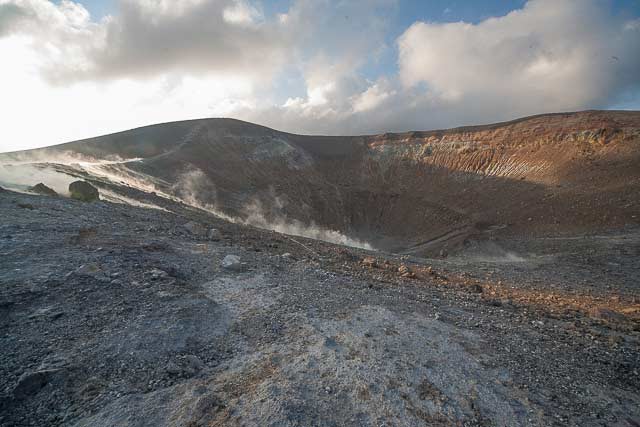|
Mount Etna volcano, towering above Catania, Sicily's second largest city, has one of the world's longest documented records of historical volcanism, dating back to 1500 BC. Historical lava flows of basaltic composition cover much of the surface of this massive volcano, whose edifice is the highest and most voluminous in Italy.
 The Mongibello stratovolcano, truncated by several small calderas, was constructed during the late Pleistocene and Holocene over an older shield volcano. The most prominent morphological feature of Etna is the Valle del Bove, a 5 x 10 km horseshoe-shaped caldera open to the east. Two styles of eruptive activity typically occur at Etna. Persistent explosive eruptions, sometimes with minor lava emissions, take place from one or more of the three prominent summit craters, the Central Crater, NE Crater, and SE Crater (the latter formed in 1978). Flank vents, typically with higher effusion rates, are less frequently active and originate from fissures that open progressively downward from near the summit (usually accompanied by strombolian eruptions at the upper end). Cinder cones are commonly constructed over the vents of lower-flank lava flows. Lava flows extend to the foot of the volcano on all sides and have reached the sea over a broad area on the SE flank.
|
|
The most recent eruption at Vulcano island is the 1888-1890
eruption from the Gran Cratere or Fossa di Vulcano,
a large crater truncating the Fossa cone. Such
eruption, one of the best observed eruption (by prof. Silvestri)
during XIX century, started on August 3rd 1889 ending (with several
breaks) on March 1890. Volcanologists use the 1888-1890
vulcano island eruption as model of the "vulcanian eruptions".

Vulcanello as seen from
Vulcano island crater rim
|
|
Recently, the Gran Cratere of the Fossa cone has been the site of
volcanic unrest which began around 1985 and ended in 1995 without
culminating in an eruption. Moreover, the most notably sign was an
increase of the fumarolic activity. This episode has triggered
increased public awareness about the volcanic risk at Vulcano and
intense studies of the volcano. Geological studies have shown that
most eruptions of the Fossa cone have been violently explosive and
produced pyroclastic flows and surges. Future eruptions have to be
expected to be of a similar character.
At nowdays a field of active fumaroles and extensive sulfur deposits
lies in the northern-central portion of this crater. It provides a
thrilling experience for those who dare to walk (or run) right
across the gas plume emitted from the fumaroles. The vivid stench of
sulfur dioxide within the plume is just the most evident indicator
of toxic gases. It is advisable to stay as briefly as possible
within the plume and better wear a gas mask. Prolonged stays in the
plume may lead to undesirable effects, such as the (irreversible)
loss of the sense of smell.
You can take a day trip to
Stromboli, but it is better to stay at least one night in order to climb
the volcano and see the dramatic lava flows and explosions against the
night sky. It's a 3 hours strenuous hike from the village base to the
summit.
:: Select one of our
MOUNT ETNA EXCURSIONS
|